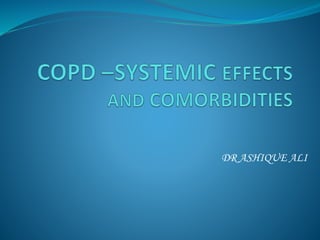This document discusses systemic inflammation and comorbidities in COPD. It states that COPD is associated with various important comorbidities that contribute to its overall severity. Markers of systemic inflammation are consistently increased in COPD patients, including CRP, fibrinogen, and cytokines. This systemic inflammation is thought to be caused by spillover from the lungs and an independent pro-inflammatory phenotype. The systemic inflammation is linked to several comorbidities like cardiovascular disease, diabetes, osteoporosis, and cancer. Cardiovascular disease is a major cause of death in COPD patients. Endothelial dysfunction and a pro-coagulant state brought on by systemic inflammation may also contribute to comorbidities.



































































![ Treatment of OSAS does not differ between patients
with COPD and those without.
Treatment of COPD patients with OSAS is based on
the treatment of constituent diseases (for COPD
bronchodilators, inhaled steroids when indicated,
rehabilitation, nutrition, domiciliary oxygen when
indicated, and for OSA weight loss and application of
continuous positive airway pressure [CPAP]).
The goal of treatment is to maintain adequate
oxygenation at all times and to prevent sleep-
disordered breathing.](https://image.slidesharecdn.com/copd-170203141109/85/COPD-systemic-effects-and-comorbidities-68-320.jpg)











